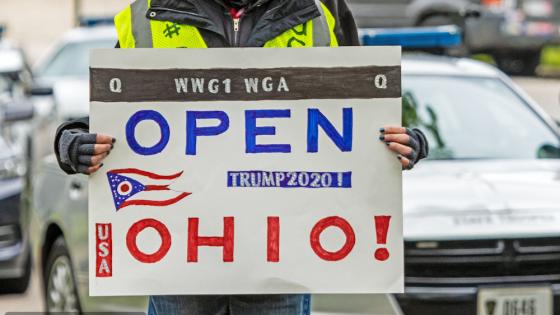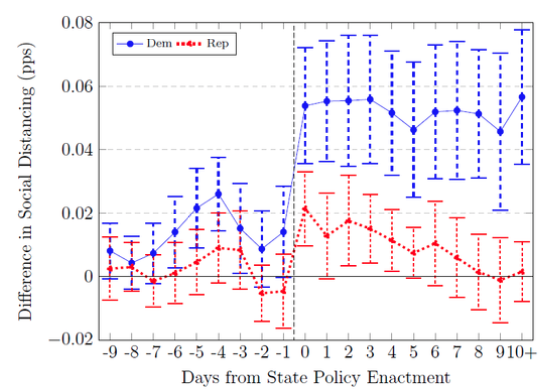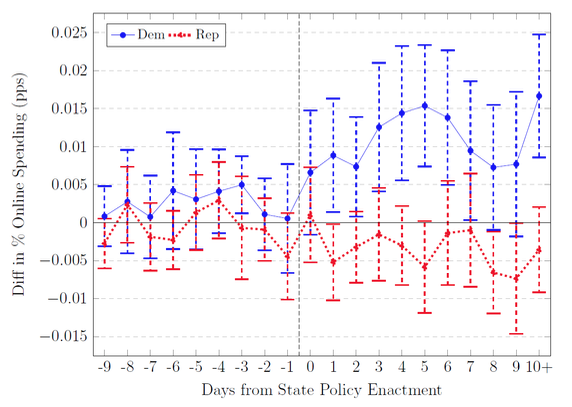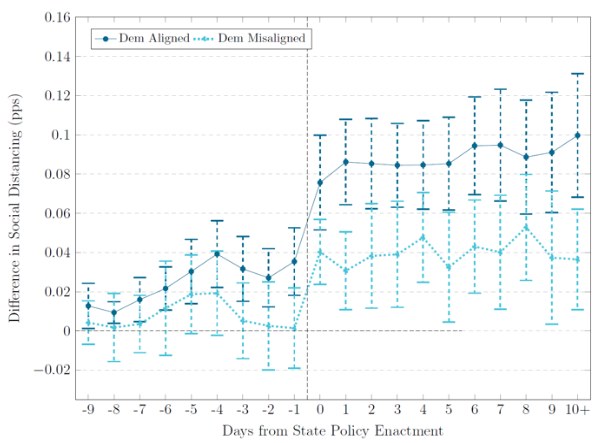With few treatment options and no vaccine yet, the current fight against the novel coronavirus focuses on slowing its spread. One of the most effective ways to mitigate the spread of COVID-19 is to practice social distancing (Baldwin and Weder di Mauro 2020). Early evidence from China shows that lockdowns substantially slowed the spread of the virus in Wuhan (Kraemer et al. 2020) and a study of the 1918 US flu pandemic suggests that social distancing does not have an adverse effect on the economy (Correia et al. 2020).
Leveraging cross-county data, Chudik et al. (2020) show that voluntary social distancing is less effective than government-sanctioned policy. Given the importance of social distancing, governments across the world have implemented various stay-at-home and shelter-in-place orders.
The political limitations of social distancing measures
These government-mandated social distancing orders are only effective if citizens comply with them. Unfortunately, the coronavirus pandemic – as with many other topics – has become a partisan issue in the US, making political beliefs a potential factor affecting social distancing compliance.1 For example, a Pew Research survey conducted in March 2020 found that 83% of Republicans agree that President Trump is “doing an excellent/good job responding to the coronavirus outbreak”, whereas only 18% of Democrats agree (Funk 2020).
This partisan divide is important as the press has accused Trump of initially downplaying the severity of the coronavirus pandemic, suggesting that Republicans may not take social distancing orders seriously (Qiu 2020).
Does this survey and media evidence extend to observed behaviour regarding whether people respond to social distancing orders in a partisan manner? Smartphone location data from SafeGraph allows us to study this question by analysing how the daily percentage of people who stay completely at home in Republican- and Democratic-leaning counties changes in response to state-level social distancing orders (Painter and Qiu 2020).
Figure 1 shows there is indeed a partisan divide in compliance with social distancing orders. Democrats increase their social distancing by over 5 percentage points more in counties with a state order compared to in counties without. In contrast, Republican counties with a state order increase their social distancing by only about 2 percentage points more than similar counties without an order, an effect that attenuates to zero nine days after the order is implemented.
Figure 1 Partisan differences in social distancing
Source: SafeGraph and The New York Times.
This stark contrast in response to social distancing orders holds up to a battery of robustness checks (including adjustments for timing, population density, local COVID-19 cases and deaths, and more). All point to the same conclusion: political beliefs affect adherence to social distancing orders.
Partisan differences in adapting to life at home
Practising social distancing requires a drastic change to our day-to-day behaviour.2 One effective way to comply with social distancing orders is to switch consumption primarily towards e-commerce. It follows then that areas that shift their consumption towards things like online retail (e.g. Amazon) and grocery delivery services (e.g. Instacart) are making a stronger effort to comply with social distancing orders.
Using debit card transaction data from Facteus, we can see how consumption towards e-commerce changes in Republican versus Democratic areas. Figure 2 shows the evidence. Consistent with what we observe in the smartphone data results, Democrats shift their consumption towards e-commerce after a state policy is implemented whereas Republicans show no significant change in purchasing behaviour. Not only are Democrats complying more with social distancing measures now, but they are adjusting their spending behaviour so they can continue to socially distance going forward.
Figure 2 Partisan difference in e-commerce consumption
Source: Facteus and The New York Times.
Political misalignment affects social distancing compliance
At least two non-mutually exclusive channels could be driving the partisan differences in social distancing. Are Democrats more informed about the potential dangers of the coronavirus or do they simply find the government orders more credible? If the credibility channel is a driving factor, we would likely see Democrats complying more with state orders made by Democratic governors than with Republican governors.
We can analyse this conjecture in the smartphone-location data by comparing social distancing changes in ‘aligned’ Democratic counties (those with orders given by Democratic governors) and ‘misaligned’ counties (orders given by Republican governors).
Figure 3 shows that political alignment influences the response of Democrats to social distancing orders. Specifically, Democrats in aligned counties increase social distancing by 8–10 percentage points more after a state policy is implemented, whereas Democrats in misaligned counties increase social distancing by 4 percentage points.
Interestingly, we find no difference in behaviour when studying misaligned and aligned Republican counties, which would be consistent with the idea that Republicans primarily follow the advice of President Trump over any state officials. These results suggest the perceived credibility of the public official issuing a social distancing order is an important influence in that order’s effectiveness.
Figure 3 Political misalignment and social distancing
Source: SafeGraph and The New York Times.
Conclusion
We are still in the early phases of the coronavirus pandemic and could see a resurgence in its spread in the fall (Reuters 2020), which means we need to learn how to maximise the effectiveness of social distancing measures today. Taken together, our results suggest that political polarisation is a major roadblock on the path to full compliance with social distancing measures.
Although our research focuses on the US, the current level of polarisation in America is similar to many developed countries including Australia, Britain, Canada, and Sweden (Boxell et al. 2020). Our results therefore have implications for many countries around the world. Republicans and misaligned Democrats are less likely to adhere to social distancing orders, suggesting that bipartisan support for social distancing measures is a key factor in how quickly we can mitigate the spread of the novel coronavirus.
Authors' note: Data provided by SafeGraph and Facteus.
References
Baldwin, Richard, and Beatrice Weder di Mauro (2020), Economics in the time of COVID-19, a VoxEU.org eBook, London: CEPR Press.
Boxell, Levi, Matthew Gentzkow, Jesse M Shapiro (2020), “Cross-country trends in affective polarization”, NBER Working Paper 26669.
Chronopoulos, Dimitris, Marcel Lukas and John O S Wilson (2020), “Real-time consumer spending responses to the COVID-19 crisis and government lockdown” , VoxEU.org, 6 May.
Chudik, Alexander, M Hashem Pesaran and Alessandro Rebucci (2020), “Mandated and targeted social isolation policies flatten the COVID19 curve and can help mitigate the associated employment losses”, VoxEU.org, 2 May.
Correia, Sergio, Stephan Luck and Emil Verner (2020), “Pandemics depress the economy, public health interventions do not: Evidence from the 1918 flu”, SSRN 3561560.
Durante, Ruben, Luigi Guiso and Giorgio Gulino (2020), “Civic capital and social distancing: Evidence from Italians’ response to COVID-19”, VoxEU.org, 16 April.
Funk, Cary (2020), “Polling shows signs of public trust in institutions amid the pandemic”, Pew Research Center, April 17. Note: poll conducted March 19–24.
Kraemer, Moritz U G, Chia-Hung Yang, Bernardo Gutierrez, Chieh-Hsi Wu, Brennan Klein, David M Pigott, Louis du Plessis et al. (2020), “The effect of human mobility and control measures on the COVID-19 epidemic in China”, Science 368(6490): 493–7.
Qiu, Linda (2020), “Analyzing the patterns in Trump’s falsehoods about coronavirus”, The New York Times, March 27.
Painter, Marcus, and Tian Qiu (2020), “Political beliefs affect compliance with COVID-19 social distancing orders”, SSRN 3569098.Reuters (2020), “CDC chief warns second COVID-19 wave may be worse, arriving with flu season”, April 21.
Endnotes
1 There are several other factors that could affect compliance. For instance, using data from Italy, Durante et al. (2020) show that areas with higher level of civic capital comply more.
2 Focusing on the residents from Britain, Chronopoulos et al. (2020) find significant changes in consumer spending during the COVID-19 crisis.





